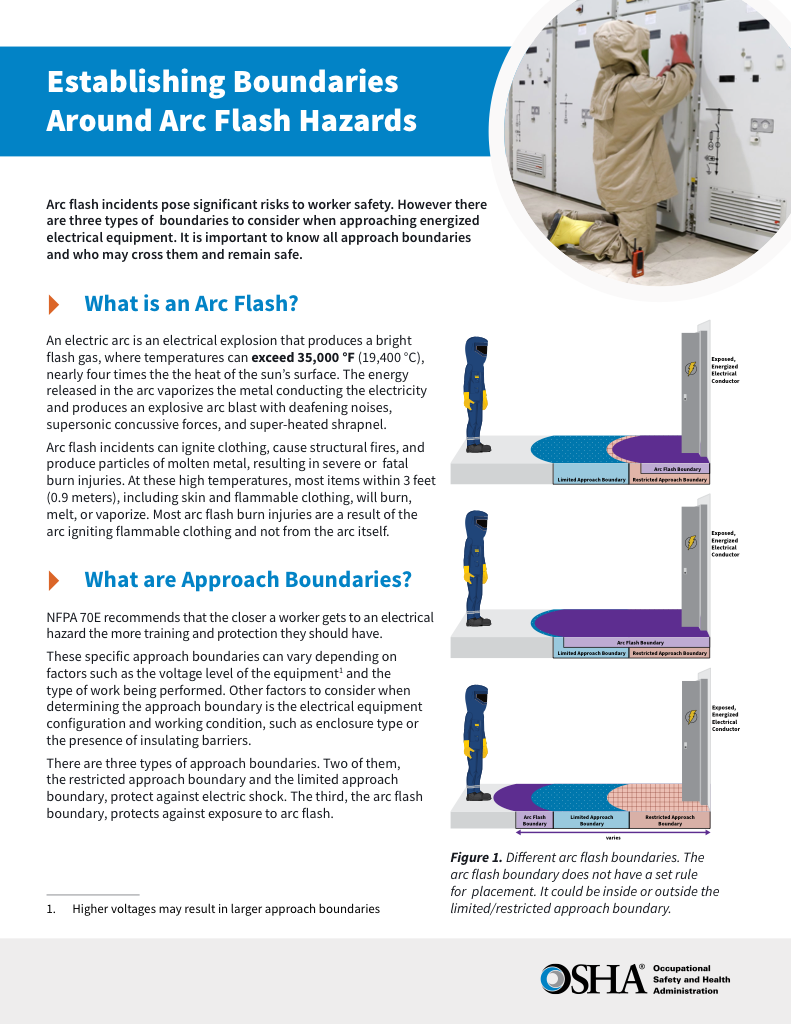Electrical Safety Requirements for Electrical Workers
CSA Z462 Arc Flash Training - Electrical Safety Essentials
Our customized live online or in‑person group training can be delivered to your staff at your location.

- Live Online
- 6 hours Instructor-led
- Group Training Available
Download Our OSHA 4474 Fact Sheet – Establishing Boundaries Around Arc Flash Hazards

- Understand the difference between arc flash and electric shock boundaries
- Learn who may cross each boundary and under what conditions
- Apply voltage-based rules for safer approach distances
Electrical safety requirements define compliance with NFPA 70E, OSHA, and IEC standards, covering arc-flash analysis, grounding and bonding, lockout/tagout, PPE selection, labeling, and maintenance procedures to mitigate electrical hazards and ensure risk control.
What Are Electrical Safety Requirements?
Electrical safety requirements are codified practices and standards to control arc-flash, shock, and fire risks.
✅ Comply with NFPA 70E, OSHA 1910 Subpart S, IEC 60364
✅ Perform arc-flash risk assessment; label incident energy
✅ Implement grounding, bonding, LOTO, and PPE programs
Electrical safety requirements are vital for reducing the risk of arc flash incidents, electrical shock, and equipment damage in industrial, commercial, and utility settings. These requirements, outlined in standards like NFPA 70E and CSA Z462, establish protocols for safe work practices, personal protective equipment (PPE), hazard assessments, and energized work procedures. Adhering to these regulations not only protects workers but also ensures compliance with occupational health and safety laws in both the United States and Canada. Understanding and implementing these electrical safety standards is essential for creating a safer, more reliable workplace. Organizations can strengthen their programs by consulting resources such as electrical safety in the workplace guidance, which provides actionable controls and documentation practices.
Complementing formal courses, arc flash safety training should cover hazard identification, approach boundaries, and hands-on PPE procedures.
In Canada, arc flash training requirements align with CSA Z462 and emphasize documented worker qualification and refresher intervals.
Request a Free Training Quotation
Electrical Safety Requirements -- Approved Materials
Only materials approved by Factory Mutual Corporation (FM) or Underwriters Laboratories (UL) should be used. Materials such as apparatus, electrical wire, equipment, and electrical wire must be used and installed as directed in the certification, labeling or listing. Using gear evaluated for arc flash protection helps ensure labels, ratings, and clearances match the system's available fault current.
Sign Up for Electricity Forum’s Arc Flash Newsletter
Stay informed with our FREE Arc Flash Newsletter — get the latest news, breakthrough technologies, and expert insights, delivered straight to your inbox.
Electrical Safety Requirements -- Qualified Personnel
Only workers familiar with electrical safety standards, electrical code requirements and related experience are qualified to work on electrical equipment. Defining who is qualified should follow electrical safety work principles that address training, supervision, and permitted tasks.
Pre-Work Electrical Safety Requirements
Employers are responsible for inquiring, determining and directly observing the location of any and all concealed and exposed live electrical circuits. If any electrical work requires a tool, a worker or a machine to cross set electrical safety boundaries, then the electrical circuits are to be grounded and de-energized. Before any approach, perform an assessment per NFPA 70E arc flash requirements to establish boundaries, incident energy, and safe work methods.
Electrical Safety Requirements For Underground Lines
Unless it has been de-energized, no auguring, drilling or other related practices are to be done within a six-foot parameter of any underground line. With that being said, all underground lines should be protected with longitudinal tape or surface signs.
Electrical Safety Requirements -- Job Briefings
Engineers and supervisors must provide job briefings for workers. Subsequent job briefings must also be held during the work term. These briefings must include:
- A job hazard analysis (JHA): All electrical hazards must be identified, discussed and placed in writing.
- Non-electrical hazards. In addition to electrical hazards, all other hazards must also be identified, discussed, and written down.
- Personal protective equipment (PPE): Employers are legally required to provide all workers with the necessary hard hats, rubber gloves, safety boots and other ANSI-standard-approved clothing. Arc-flash protection clothing meeting NFPA-70E standards must also be provided.
To ensure consistency, NFPA 70E training requirements recommend documenting briefing content, worker comprehension, and corrective actions.




